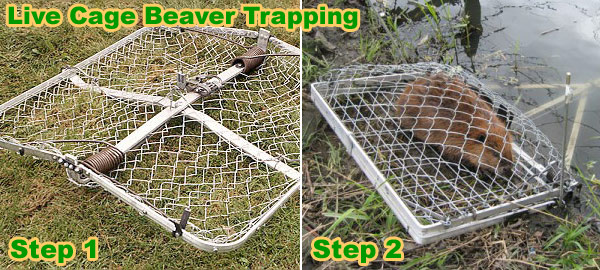- info@wildlife-removal.com
Call us for help in your town
Wildlife Removal Education
Beaver Trapping Tips, Bait
Need beaver removal in your hometown? We service over 500 USA locations! Click here to hire us in your town and check prices - updated for year 2020.
Beaver trapping is not easy for amateurs. No wildlife trapping is, but this animal is particularly tough. If you have trouble and want to hire a pro like me, someone with experience,
click on this map of Professional Wildlife Removal Companies, and you'll find an expert in your town or city.

Let’s look at the facts. You’ve got trees down, stumps filed to a suspicious point. Large rodent footprints are everywhere, and the water level in your stream is rising. From the bank of the creek, you feel like someone—something—is watching you. When you turn to look, a brown, furry body slips into the pond without so much as a ripple. You don’t need an expert to tell you; you’ve got a beaver problem.
One of the largest rodents, beavers are considered problem animals when the dams they build encroach on human property, disrupting water flow and damaging trees. A beaver isn’t going to take in consideration how close a tree is to your home or building when he starts to gnaw on it. The beaver needs to chew, and that’s exactly what he plans on doing. You cannot prevent a healthy beaver from chewing. This animal’s teeth constantly grow, and if the teeth are not maintained, they will grow so long the beaver cannot eat.
Since poisoning beavers is not an option, and there are no working beaver repellents on the market, the only option you have is to trap and remove the beaver. Actually, let me revise that; you need to trap and remove the beaver family. You will almost never have just one beaver if there is a beaver den. Living in colonies of up to eight, one beaver is usually indicative of another beaver. It has been known for a beaver to be solitary, but that is the exception, not the rule.
There are two basic types of beaver traps - live traps and lethal traps. Live traps include very large cage traps, or clamshell traps like shown above. Lethal traps include drowning snares, leg hold traps, and the most popular, the connibear style
body grip trap, as shown below. If you set a live trap, you can use bait. The best bait to trap a beaver is the castor scent of another beaver! You can get this from your last capture, or buy it from a trapper supply. If you are using lethal traps, it's all about location.
There are two main types of beaver sets. Channel sets, in which the trap is set on an actively used beaver runway, or channel, which is easy to spot. Mound sets are set at the beaver lodge. Basically, anywhere were you can tell a beaver has made a pathway that it uses
repeatedly. To learn more, read my How To Kill a Beaver page.

Some people have had minor success in beaver control with wrapping their trees in a wire mesh, but this tactic is impractical if you own an entire forest. Harassing the beavers by destroying dams and dens is usually ineffectual as well. A beaver can rebuild a dam in less than a day. If food is still available, trees plentiful, and water flowing, destroying a dam will only make a beaver gnaw down more trees. These futile efforts will just make you angrier and won’t bother your beaver companion at all.
Trapping beavers may be tempting to the novice homeowner. It is a job that should be left to someone with experience. Beavers are timid animals and very intelligent. If you attempt to trap a beaver and fail, there is a good chance the beaver will forever avoid your trap and anything that resembles it. Most states require a special license to trap beavers, so be sure to look into local laws before attempting to remedy your problem. A beaver that is trapped professionally may be relocated or humanely euthanized if the situation warrants it.
Trapping beavers is not about selling pelts as it used to be in the frontier days. Professionals are not collectively conspiring to wipe out the beaver population and become millionaires by selling the fur. Wildlife experts are there for your protection and peace of mind. If you suspect a beaver is eyeing your creak or pond, or if you’ve already suffered hundreds of dollars in property damage, use the directory and give a professional a call.
For more info, got back to my Beaver Removal page.


















